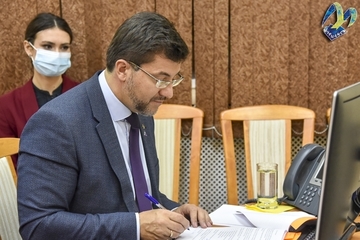
The Swedish city of Luleå is located on the coast of the Svartöstaden peninsula, at the mouth of the Gulf of Bothnia (Lule Bay). At the same place, the Lule River flows into the bay, making the city an important port in north-east Sweden. A significant part of the city"s territory (2,100 km 2) is industrial and transport buildings, port facilities. One of the largest districts of the city is located on the nearby island of Hertsen – the seventh most populous island in Sweden. There are 57679 inhabitants in the city.
Luleå Port – the fifth largest in Sweden – handles over 7 million tons of cargo annually. It is of particular importance to the operations of the Swedish mining company LKAB (Luossavaara-Kiirunavaara AB), which develops iron ore deposits in the Kiruna and Gallivare areas (Malmberget mine). In winter, the movement of ships does not stop thanks to the work of icebreakers; Luleå is the home port of the Swedish icebreaker fleet.
The Luleå archipelago consists of 700 bays and islands, and its territory extends to the northern (Swedish-Finnish) border of the country. Archaeologists have discovered a large number of labyrinths, which are believed by many to have been used in rituals related to fertility and agriculture. There are about 300 similar labyrinths around the world, built on the same model, one hundred of these structures are located on the islands of the Luleå archipelago.
Already in the 13th and 15th centuries, Luleå was an important port city. In 1621, the Swedish monarch Gustav Adolf presented the city with a royal charter – a document on the founding of the city. Luleå was founded in what is now the town of Gammelstad ("Old Town") ("Gammelstad"). In 1649, due to a rise in the level of the ground, in connection with which the bay became too shallow for the passage of ships, the city was moved to the place where it is today. Gammelstad Church is a UNESCO World Heritage Site.
In 1887, a strong fire destroyed most of the city, only a few buildings survived. The neo-Gothic cathedral (the historical name is the Church of Oscar Frederick), erected in 1893, is the tallest building in the city (67 meters).
The city"s main business areas are industry, research, education, trade and the service sector. The university"s educational programs have made the city attractive for the development of new business areas, as well as for international companies opening local offices in the city.
A large number of jobs are created by the Swedish steel company Svenskt Stål AB (Swedish Steel) and the Luleå University of Technology. The Norrbotten division of the Swedish Air Force, F 21, is based in the vicinity of Luleå Airport. Other major employers include Ferruform (a subsidiary of Scania AB) and Gestamp HardTech (which became the property of Svenskt Stål on 1 January 2005) AB).
About 2,000 people are employed in the field of information technology (data for 2008). Luleå is home to several major innovations and important technological breakthroughs.
Luleå is home to a large number of cultural institutions, including the Norrbotten Theater and the Norrbotten Museum. The city is also known as the birthplace of a major musical group led by Tim Hagans. In January 2007, the House of Culture (Kulturens Hus) was opened. It houses a library, concerts and art exhibitions. The punk band Raised Fist and The Duskfall, known for their heavy but melodic rock, originated and developed in Luleå.
The Mayor of Luleå is Ms Karina Sammeli.
Official site of Luleå:
http://www.lulea.se/language/english/how-lulea-is-governed.html
